Senate Hills, of Hillsboro, Oregon, has been making things for as long as he can remember. His current project is a framed wooden shed with cedar-shake siding for his six trucks. Before this, he built two other sheds, one of which has a ramp and accommodates the wagon he uses for light hauling. For loading logs, he built a boom derrick operated by a steam donkey.
Senate is 11 years old. His trucks and heavy equipment are all toys, most of which he has made. He started building things in cardboard, but when he was six or seven, he turned his hand to working more substantial materials. He and his dad, Jeff, were fixing a table when Senate spied a piece of plywood about 18″ long by 7″ wide, pointed at one end. He thought, “I could build a boat out of this. I screwed some boards to the sides, added a keel, which increased the draft from about 3⁄4″ to about 4″, attached a rudder, which I’d made out of a small hinge and a wooden board, and screwed a tiller to the top. I kept the boat from leaking by driving hemp twine into the cracks using a flat-head screwdriver and a hammer.”
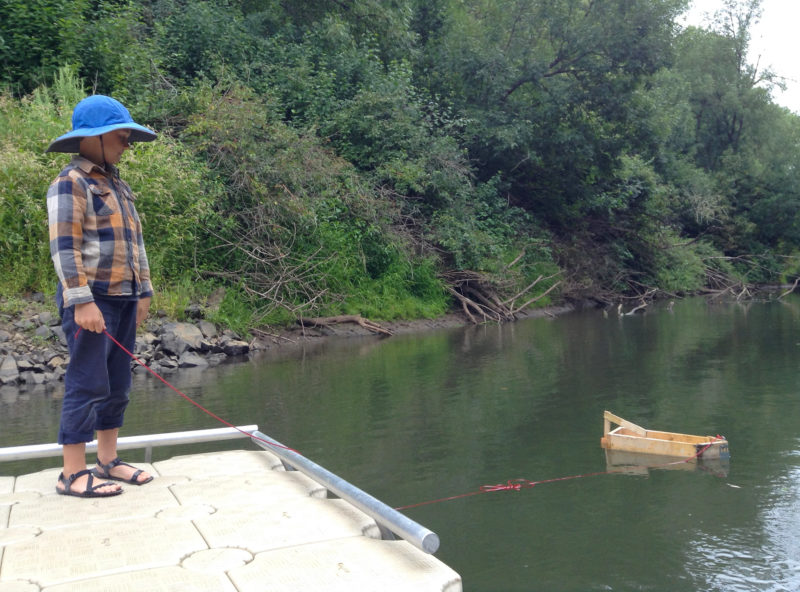 Melissa Hills
Melissa HillsA young Senate tested his first wooden boat, DRIFTWOOD, on the Tualatin River.
The family took the new boat to the beach on the Oregon coast where Senate christened her DRIFTWOOD before launching her. As she bobbed in the shallows of the Pacific Ocean, Senate imagined her as an inboard fishing boat.
That summer Senate built all manner of experimental boats. Almost every week the family went to nearby Tualatin River and almost every week there was a new boat to christen and launch. They were, he says, “weird little things, just experiments really, but they almost all worked.”
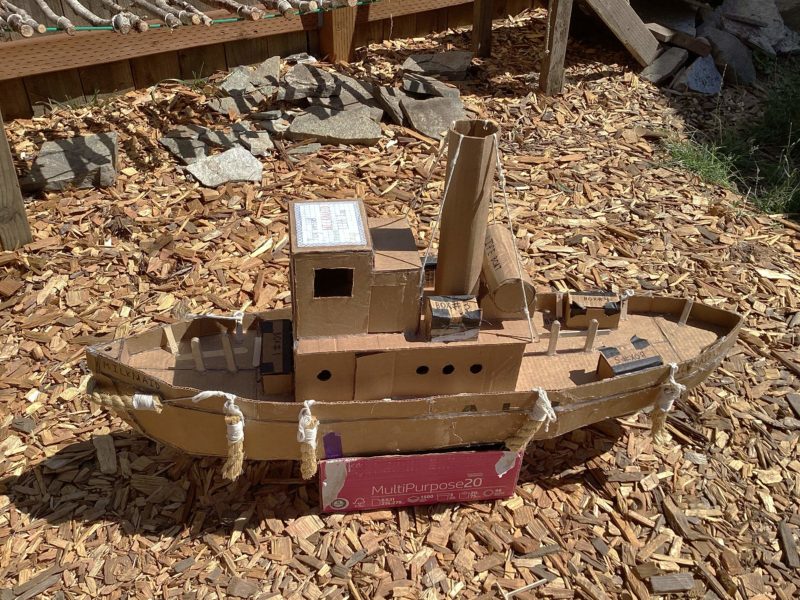 Senate Hills
Senate HillsSenate’s interpretation of a harbor tug is MILKMAID, named after “The Milkmaid,“ a song by his favorite band, The Longest Johns, a folk and shanty group from Bristol, England. Senate was inspired when reading On The Hawser: A Tugboat Album by Steven Lang and Peter H. Spectre, and Tugboats Illustrated by Paul Farrell. MILKMAID is 3′ LOA by 8″ beam.
There is no boating in Senate’s background, but when the pandemic hit and the Hills family went into lockdown, Senate’s mom, Melissa, decided to subscribe to a couple of magazines they could all enjoy. One was National Geographic, the other was WoodenBoat. Senate read the latter from cover to cover and was hooked. He continued to create the cardboard and plywood vessels of his imagination but also started building small, simple, model boats from kits. His favorite model boat, he says, is PADDY, a radio-controlled Beaver Tug that he built with Jeff from plans and templates they found on the internet.
“We built her of balsa,” says Senate, “and installed a radio-controlled motor. We sheathed her in cotton fabric soaked in epoxy to make her stronger and watertight. And we painted her to look like a real working tugboat; she even has miniature tires for fenders.”
As the pandemic restrictions slowly eased, Melissa began looking for family outings. First came a tour on ARROW Nº2, a retired and restored Columbia River pilot launch based in Astoria (which Senate got to drive during the family’s visit) and then, in the summer of 2022, Senate, Melissa, and Jeff joined seven other families on the banks of the Willamette River for the annual Family Boat Build put on by the RiversWest Small Craft Center.
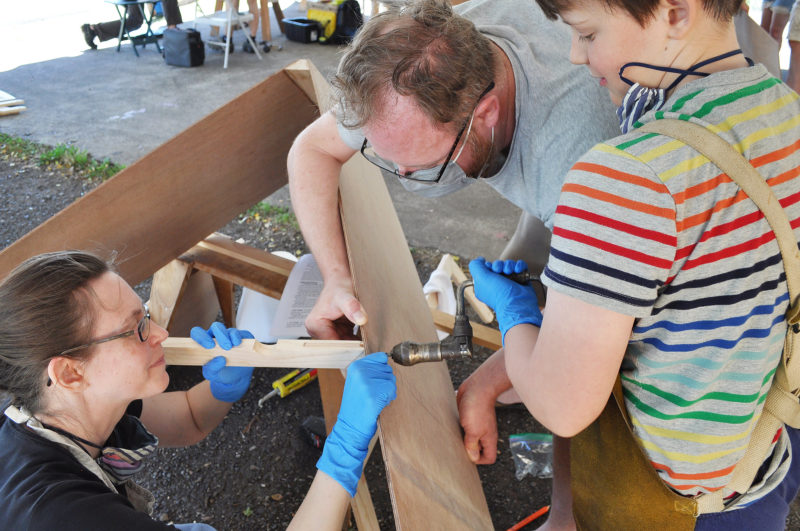 Ralph Cohen
Ralph CohenWith the side panels in place the family worked together to frame the skiff. Jeff held the panel, while Melissa held the forward frame steady for Senate to drill into using the bit and brace.
Over this two-day weekend workshop in Portland, Oregon, the goal was for each family to build a Salt Bay Skiff—complete but unfinished. The Hills family worked as a team, but they agreed that it was Senate’s project. “RiversWest had set up stations with all the parts and the instructions, like a kit,” says Senate. “RiversWest members helped by demonstrating and explaining how to do things if we weren’t sure, but we did all the work ourselves. I was the senior shipwright, my dad was the tool specialist, and my mom made sure we followed all the instructions.”
The Salt Bay Skiff, designed by Chris Franklin, is a simple 12′ stitch-and-glue skiff that can be built from two sheets of plywood. It is an ideal project for beginning boatbuilders. It has a deep skeg, outside chine logs, and can carry a load of up to 300 lbs. While it can be built and rigged for sail, the Hills family chose to build their boat for rowing. Senate had no previous experience with small boats and wanted to take things one step at a time.
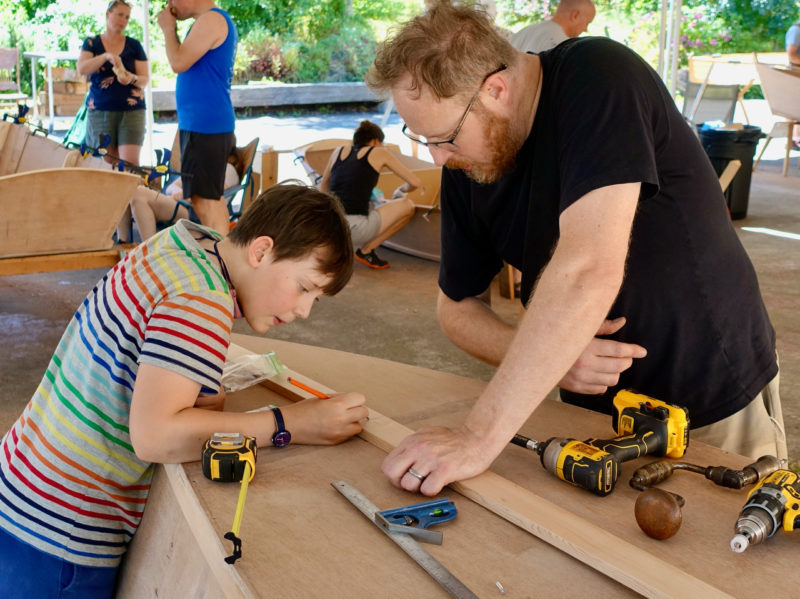 Meg McGill
Meg McGillWith Jeff looking on, Senate marks the keel for a screw placement. Fixing the keel and chine logs would be the final steps before turning the boat over.
The weekend was hot but despite numerous breaks to cool down and rehydrate, Senate and his parents stayed on schedule. Apart from the heat, Senate says, the hardest part was “attaching the side panels to the stem. At that point there’s nothing holding the plywood panels in place, and they flopped around a lot. But it got easier as we attached the stem, then the forward frame, the midships frame, and the transom. After we attached the bottom sheet and the chine logs, it felt really stable. Then we turned it over and it already looked like a boat!”
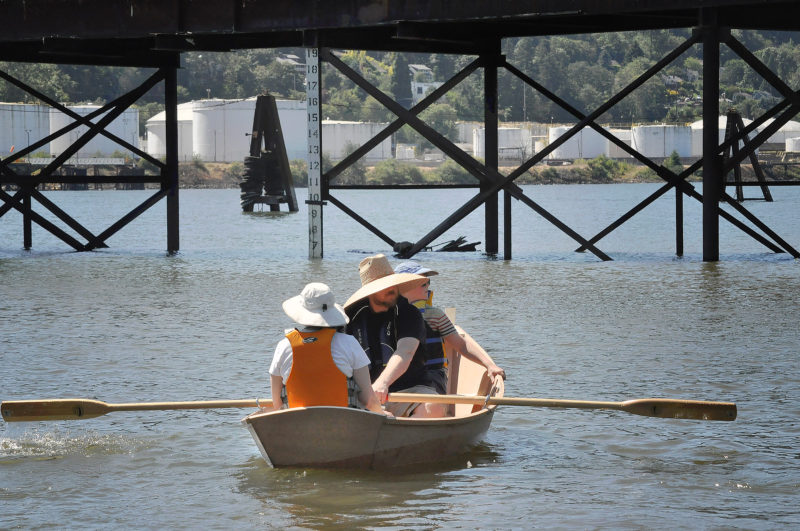 Ralph Cohen
Ralph Cohen“We built that!” The Hills family take their skiff for its first outing. By the end of the Family Boat Build weekend, the boat was structurally complete but there was still a lot of finishing work to do.
By the end of the weekend, they had fitted all the pine thwarts, quarter knees, and breasthook, and the skiff, while not yet painted, could be taken out for a test row on the Willamette River. “It was exciting,” says Senate, “There was the ‘We built that!’ moment. All three of us went out. For the sake of balance, my dad rowed, sitting on the middle thwart. I’m glad we did it, but we quickly knew that having all three of us on board was too much. There was very little freeboard and in the wrong conditions the boat would be easy to swamp.”
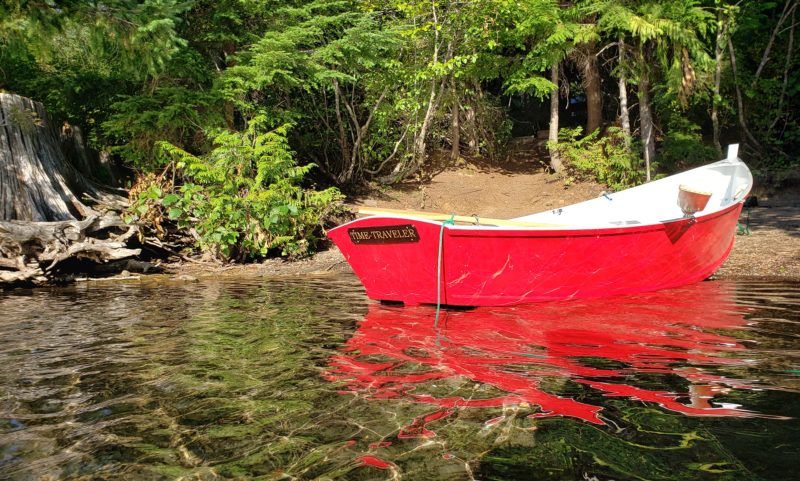 Jeff Hills
Jeff HillsAfter filling, sanding, and many coats of paint, TIME–TRAVELER’s topsides shine. Protecting the finish is important to Senate, so he and Jeff added a brass shoe to the skeg and are working on fenders for the topsides when alongside the dock.
After the weekend, Senate went straight to work finishing the skiff at home. “We had to make sure all the screwheads were countersunk, and then we filled and sanded and painted.” Indeed, Melissa and Senate would spend weeks painting. “We sealed everything with primer,” says Melissa, “and then painted many coats of bright red and gloss white. We added a nonskid to the bottom inside. We taped off where we didn’t want texture, painted a coat of white, sprinkled sand over the wet paint and then covered it with a final coat on top of the sand.” Jeff and Senate shoed the skeg with a brass half-oval strip because, Melissa says, “Senate was very concerned after the first few times using the boat that the skeg was getting chewed up.”
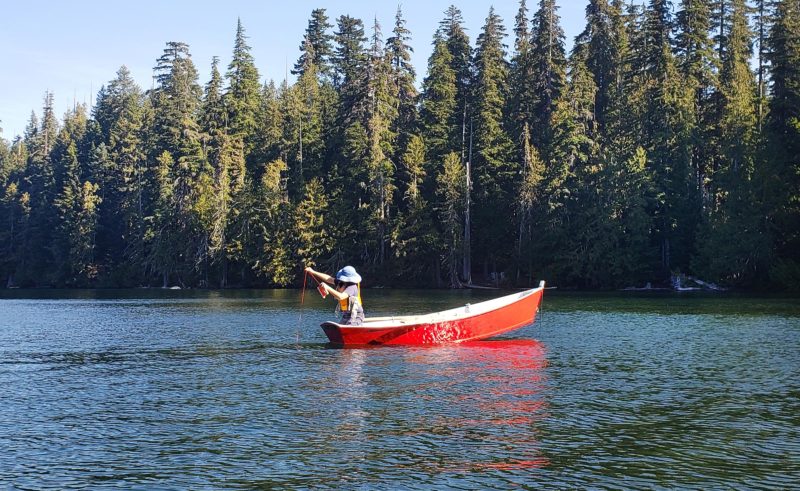 Jeff Hills
Jeff HillsAs well as rowing, Senate uses TIME–TRAVELER to survey the lake. His sounding line is 200′ long with knots every 1′ for the first 10 and then every 10′ up to 200′.
Senate named his skiff TIME–TRAVELER because “when kids go out in boats,” he says, “we lose track of time.” In the year since the Family Boat Build, Senate has taken TIME–TRAVELER out “so many times I’ve lost count. She’s really nice to row and I’ve noticed that even when going into waves she still performs well. If you really lean into the oars, she’ll go fast. Sometimes I give my parents rides, but I’d say the optimum is just me or me and one other person. With a passenger you just have to get the weight distribution right, but otherwise, the only downside is less freeboard.”
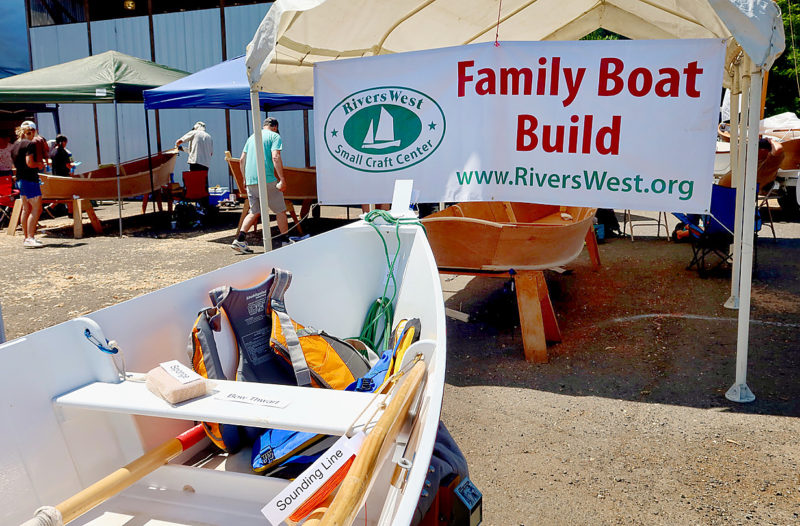 Meg McGill
Meg McGillIn 2023 Senate volunteered to bring TIME–TRAVELER back to the RiversWest Family Boat Build weekend to help families who might be unfamiliar with the building process and with the terminology.
Senate and TIME–TRAVELER returned to Family Boat Build in 2023, not to build another boat, but to help. Senate had made display cards identifying all the boat parts. He answered many questions—especially at the beginning of the weekend—and helped to fetch tools and parts, held things in place when an extra pair of hands was needed, and offered advice and encouragement to the new builders. He also brought some of his favorite books about boats to share.
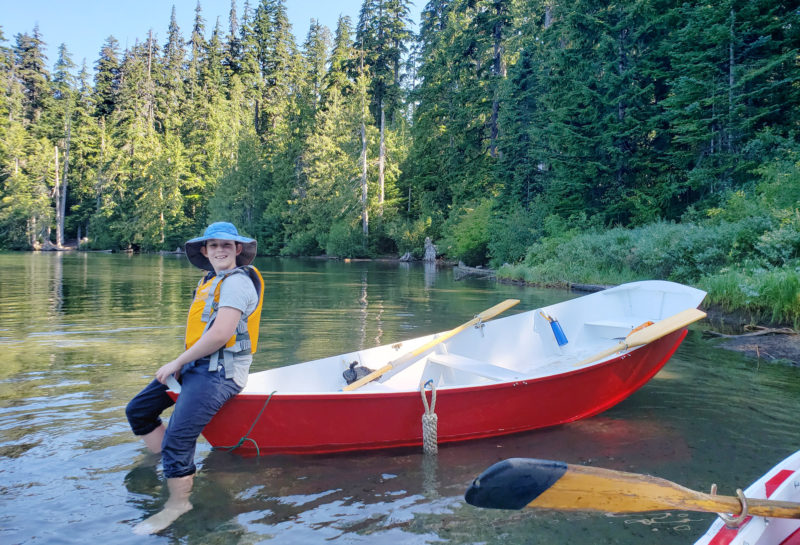 Jeff Hills
Jeff HillsSenate and TIME–TRAVELER on a visit to Lost Lake in the Mount Hood National Forest, Oregon. The rope fender, made by Jeff, is the first of a set that Senate will be making.
While he’s busy getting on the water as much as possible in TIME–TRAVELER, Senate continues to draw, build, and dream. He hopes, in a few years, to build a sailboat, something he can construct himself and learn to sail in. “I don’t know how to sail,” Senate says. “I’ve never even been on a sailboat. So that would be an ambition.” In the end though, he says, he just wants to go on learning new things. “I think that’s what life is about…learning…you’re never really finished.”![]()
Jenny Bennett is managing editor of Small Boats.
Do you have a boat with an interesting story? Please email us. We’d like to hear about it and share it with other Small Boats readers.
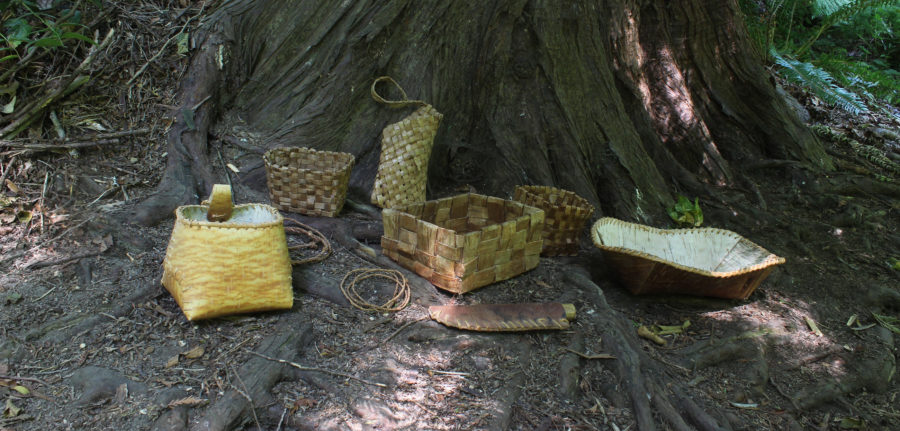
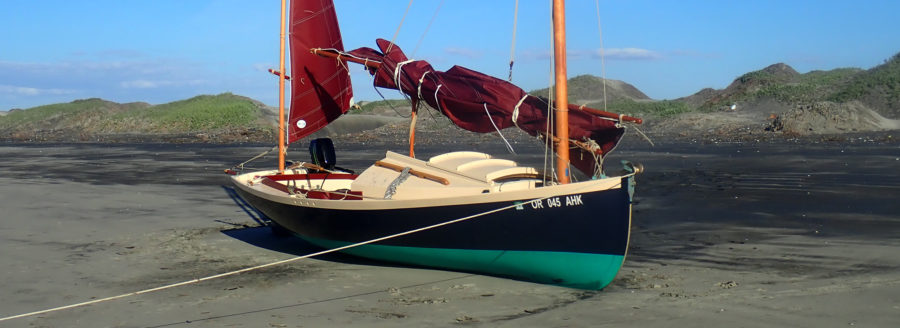
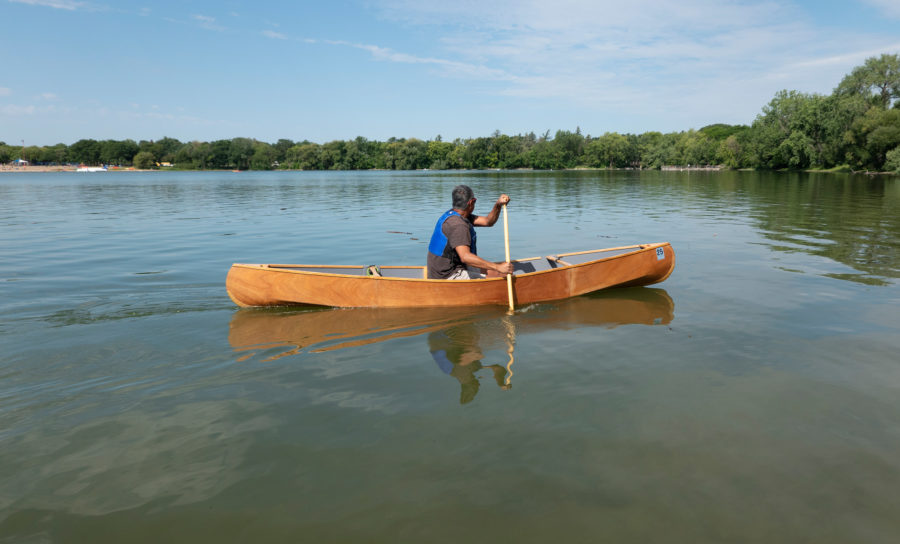
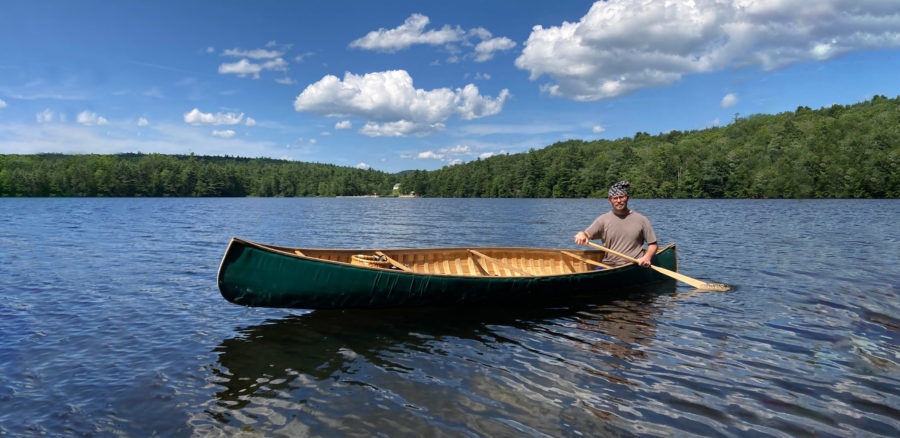
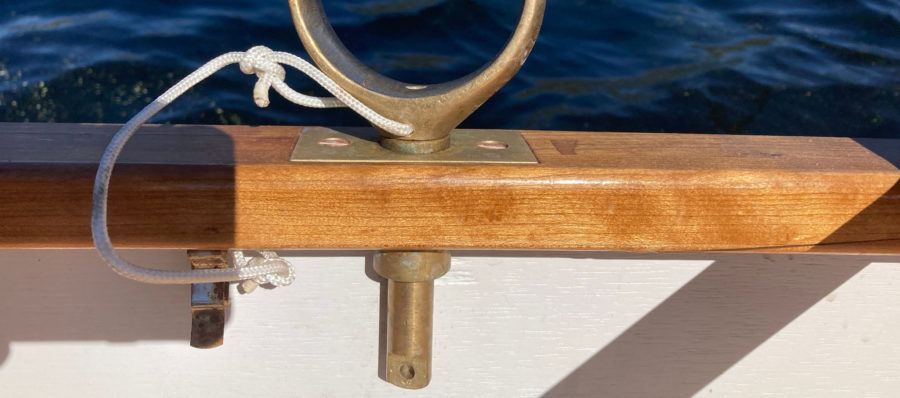
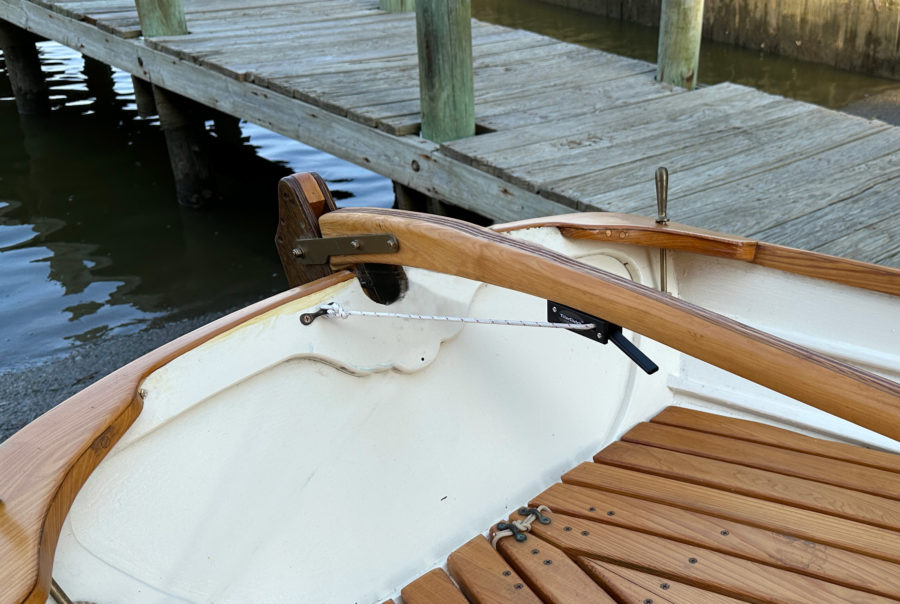
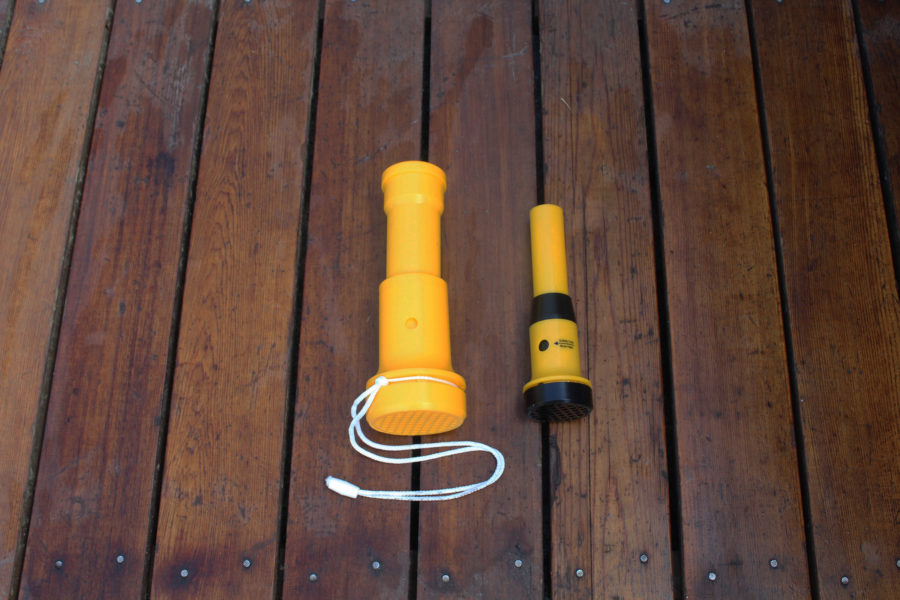
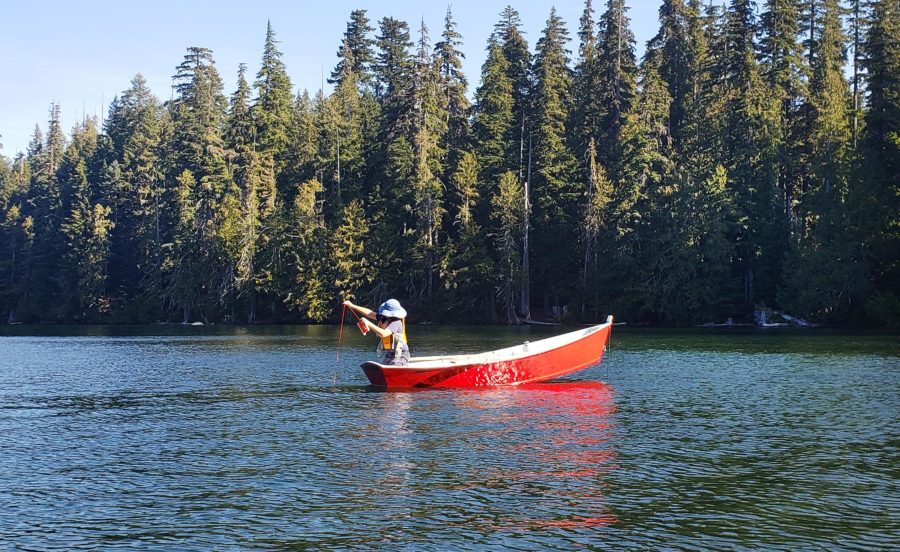

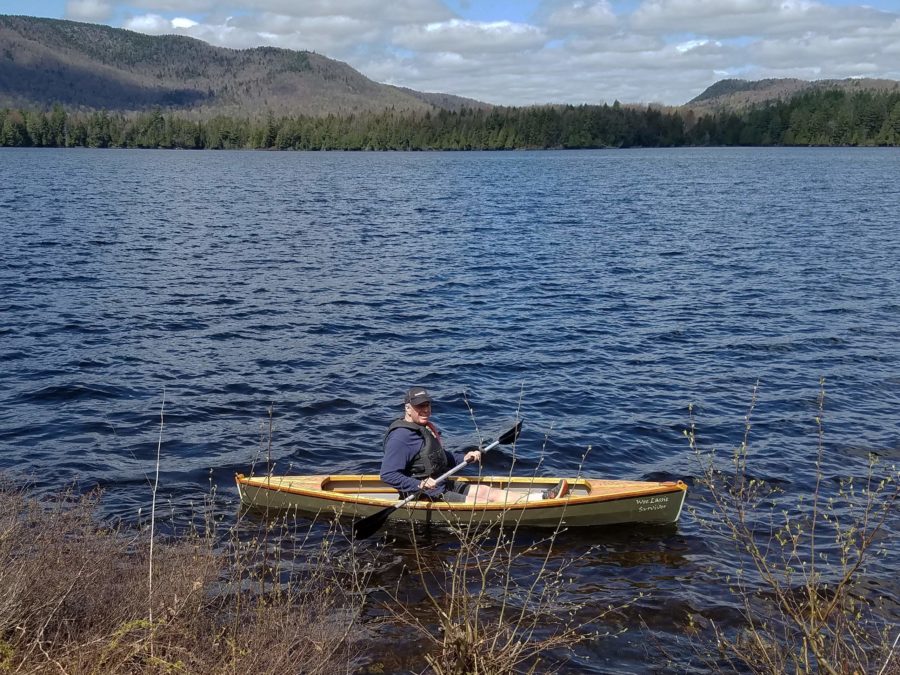
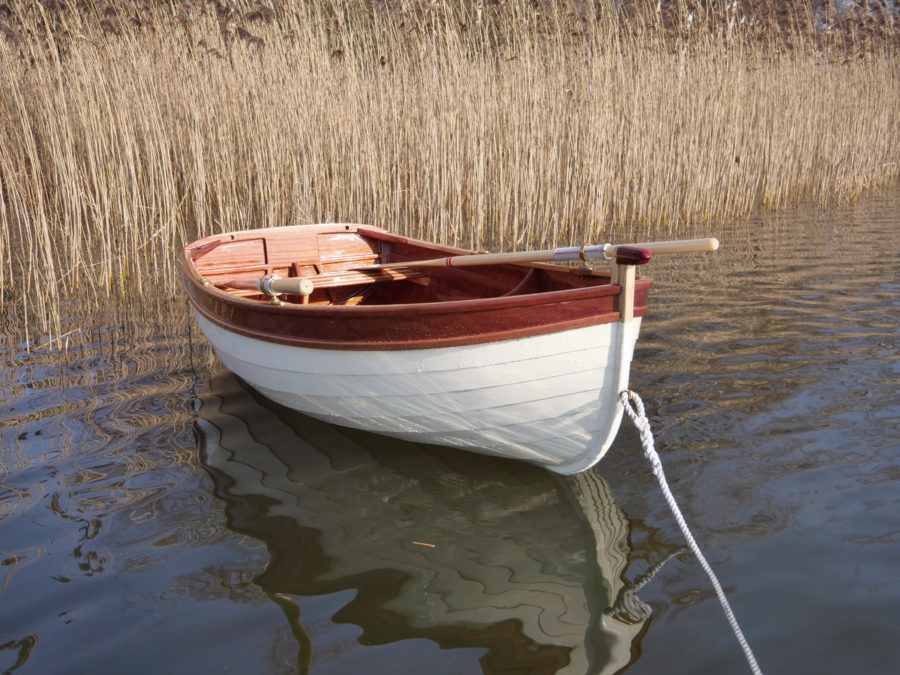
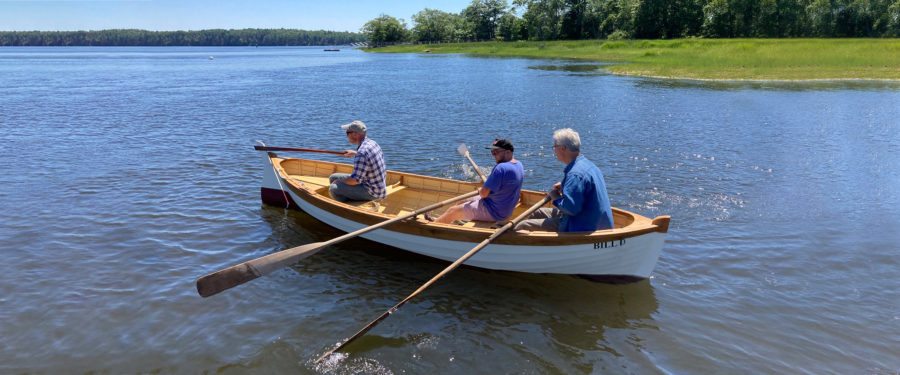
Senate, that is a beautiful Salt Bay Skiff! Congratulations to you, and your folks as well.
I’m about to launch my own Salt Bay Skiff, built over an excessively long number of months, thanks to all the things that come up in a retired adult’s family life that get in the way of boat building. I’m planning to row and sail it, so I’ve set it up for a boomless sprit sail rig that won’t be speedy, but should be safe for lake sailing here in northeast Oklahoma. Do some reading about how to sail, and you might want to set up your skiff for sailing too. Thanks for the photos and great article. Fair winds and calm seas to you!
Your tales about the Tualitin brought back fond memories of my boyhood. My dad and I used to fish the river, though not with a great deal of success. My dad built an 8′ skiff from a plan printed in How to Build 20 Boats, an annual magazine with boat plans. It’s sad that magazines no longer publish plans for home building. There used to be several, including The Rudder‘s Ideal series, Sports Afield‘s Boat Building Annual and various ones from Popular Mechanics and other publishers.
The design my dad built was called “Matey,” a little 8′ skiff. I learned some interesting things about little boats, such as the fact that a skiff should have its transom clear the water (a passenger in Matey would cause the transom to drag, making the boat a beast to row. It would lose way after every stroke of the oars. Another passenger in the bow would actually improve that aspect, though of course it was overloaded thus burdened)
After saving up strawberry-picking money, I bought a 1930s twin-cylinder Evinrude, allegedly 4 hp, from a colleague of my dad’s; I tried this out on the Tualatin with a classmate aboard; the little motor was cranky to start (no recoil starter; you had to wrap the starting rope around the flywheel for every attempt). When the motor finally caught, it was cocked over, making the boat spin in place, giving us a good scare.
I hope you will build more boats. I’d suggest some designs by Phil Bolger. You can build directly from the books (they would prefer you buy larger scale plans), and many of them are small and simple, and there are some good ones to learn sailing in
What a great project!!
I am envious of you getting started building boats at your age. One word of caution: It is addictive!!! ;o)
I would have loved to have someone to guide me along to build a boat at 11.
Great job!!
Wonderful story, wonderful boat! Congratulations Senate!!
Hey Senate,
What a beautiful vessel you built, and a fine crew behind you. We’re curious how your sounding project is going… are you charting as you go?
Looking forward to hearing more of your ongoing adventures!
Dave and Anke
Hi Senate,
It was great to read your story and learn more about how you came to be interested in boat building. I hope you do learn to sail and keep pursuing your interest in boating. You are showing the aptitude of someone destined to become an engineer!
Best wishes.
Ralph Cohen
RiversWest Newsletter Editor